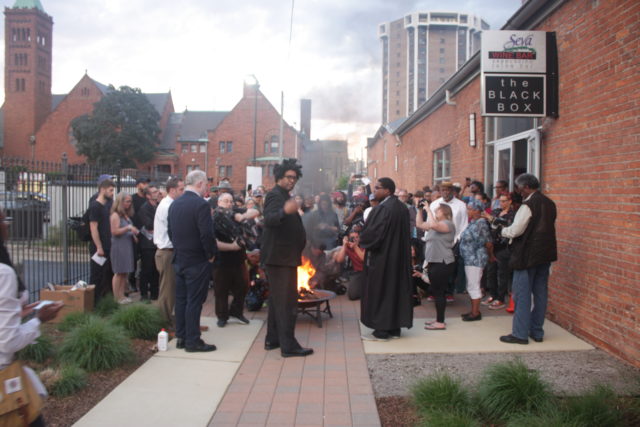DETROIT—Of all the bitter divisions in 2017 America, it’s hard to believe one of the hottest flashpoints has been a 156 year old failed rebellion. Yet in recent weeks violent clashes have broken out over Confederate symbols across the South. Activists celebrating the long-overdue removal of Confederate monuments in cities such as St. Louis and New Orleans have been met with Right-Wing counter protesters, some carrying automatic weapons. When I raised this concern to artist John Sims ahead of his Confederate-flag-burning performance on Memorial Day, he didn’t seem too worried: “This is Detroit.”
And sure enough, the mood yesterday in America’s most African-American major city (Sims’ hometown) seems to have been somewhere between powerfully cathartic and celebratory. Burn and Bury:Detroit 2017, at the N’Namdi Center for Contemporary Art, brought together activists, artists, clergy, performers, and community members to put the damn thing to rest in a theatrical funeral. Conspicuously absent: protesters trying to defend the flag’s racist legacy.
The Memorial Day ritual was the latest in Sims’ ongoing project to unpack the loaded symbol. In 2015, the 150th anniversary of the Civil War’s end, the artist (who is African-American) organized funerals for the flag in 13 states. Following the horrific Charleston shooting that year, Sims decided to broaden the project’s scope—Confederate flag burnings spread to all 50 states on the 4th of July. Now, he aims to make it an annual Memorial Day tradition:
“To remember the horrific legacy of American Slavery and to honor all of the soldiers of justice who have fought against slavery, Jim Crow segregation and contemporary white supremacy, there is a call to Burn and Bury the Confederate flag, all across the United States of America every year on Memorial Day.”
It makes sense that the Detroit iteration of Burn and Bury didn’t receive the same backlash or intimidation that similar actions have received. Detroit is, after all, a majority African-American Northern city that’s suffered greatly as a result of racism—its populace descendant from Southerners lured up by the false promises of manufacturers seeking cheap labor. Today the city is about 10% white, and based on Periscope documentation of yesterday’s event, it seems those residents turned out in support too. Scanning the crowd, it looks like white people might’ve made up more than a tenth of the attendees. That also makes sense.
What’s surprising to me (but probably shouldn’t be) are the white Americans who still cling to the Confederate flag and attempt to extricate it from the legacy of slavery and contemporary racism. As a white person from a relatively-recently-immigrant family, I’ve always been baffled and embarrassed by white “American” American history. The people who want to defend their ancestors’ atrocities are downright confusing. You’d think they’d be the ones scrambling to light the first match.
And maybe, with actions such as these, that’s finally going to become more common. When I checked in with Michaela Mosher, N’Namdi Center for Contemporary Art’s Gallery Director, ahead of the performance, she offered one explanation for the lack of white backlash here: “We’re hoping people can understand it’s a cathartic artist’s performance—we’re trying to add a different narrative.”
Catharsis is definitely in demand in the country. For one day a year, Burn and Bury might offer just that. A new holiday tradition, started by an African-American artist, could become something everyone can rally around when confronting our nation’s awful past (and its contemporary effects). It’s obviously important to not sweep slavery and the Confederacy under the rug, but instead create a new way of collectively memorializing the era without glorifying it. Thankfully, Sims is planning to keep doing that year after year: “I’ll be doing this again next year somewhere else. The aim is for this to become a serious ritual—especially for African-Americans—that we can annually celebrate. If we can celebrate the 4th of July, we can celebrate a day that reflects the end of white supremacy in the Confederate South.”




Comments on this entry are closed.